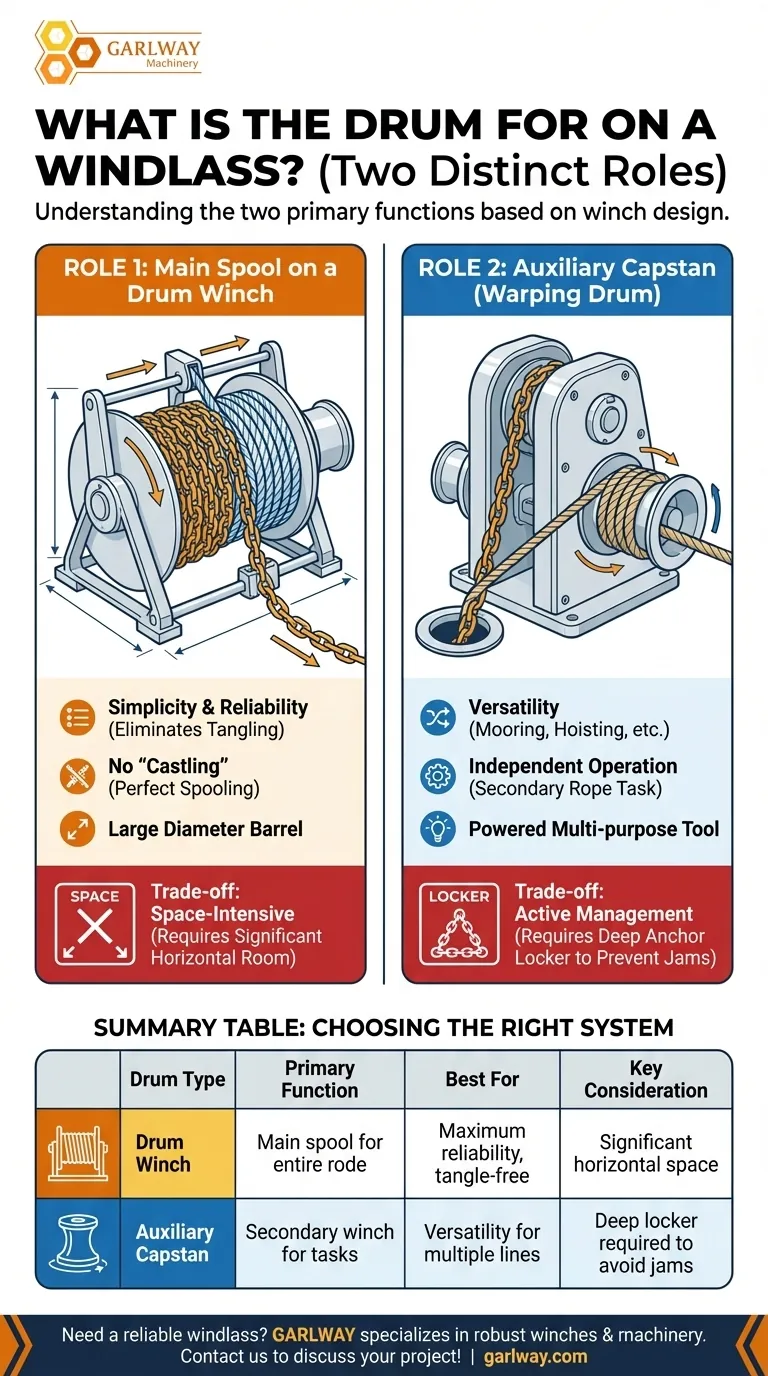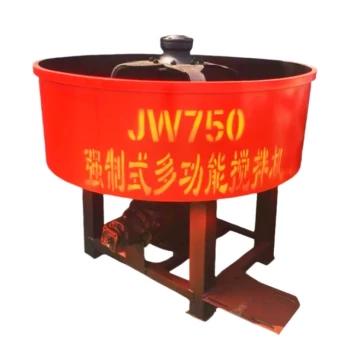In short, a drum on a windlass serves one of two distinct purposes depending on the winch's design. On a "drum winch," it is the large primary spool that stores the entire anchor rode (the rope and/or chain). On a more traditional windlass, the smaller drum, often called a capstan or warping drum, is used as an auxiliary winch to handle a secondary rope for tasks like mooring or hoisting.
The term "drum" can be confusing because it applies to two different components on two different types of anchor windlasses. The key is to first identify whether the drum is the main storage system for your anchor line or a secondary, independent capstan for other onboard tasks.

The Two Primary Roles of a Windlass Drum
Understanding the design of your windlass is the first step. The drum's function is fundamentally different between a "drum winch" and a standard windlass that features a gypsy (for chain) and a capstan drum (for rope).
Role 1: The Main Spool on a Drum Winch
On a drum winch, the drum is the centerpiece of the entire system. It is a large-diameter barrel that neatly spools the anchor rode under power.
This design ensures the rope and chain are laid evenly onto the drum every time. This direct spooling action effectively eliminates the risk of the rode tangling or jamming as it's retrieved.
Role 2: The Auxiliary Capstan (Warping Drum)
On many vertical and horizontal windlasses, you will find a chain gypsy on one side and a separate, smaller drum on the other. This is a capstan drum, also known as a warping drum.
This drum operates independently of the gypsy and is designed to handle a secondary rope. It allows you to use the windlass motor's power for tasks beyond anchoring, such as tensioning a mooring line or hoisting a person up the mast in a bosun's chair.
You use a capstan by wrapping a rope around it several times; the friction allows you to haul heavy loads without having to store that rope on the drum itself.
Understanding the Trade-offs
The two designs solve the problem of anchor retrieval in different ways, each with its own set of advantages and disadvantages.
Drum Winch: Simplicity vs. Space
The primary benefit of a dedicated drum winch is its simplicity and reliability. Because it spools the entire rode, issues with the chain piling up in the anchor locker (known as "castling") are completely avoided.
The major trade-off is space. The large drum holding hundreds of feet of rope and chain requires a significant amount of horizontal space in or near the anchor locker, which may not be feasible on all boats.
Gypsy/Capstan Windlass: Versatility vs. Management
The main advantage here is versatility. The independent capstan drum provides a powered winch for a variety of tasks, making it a multi-purpose tool on the bow.
This design requires more active management. The anchor rode simply falls into the locker below the gypsy. If the locker isn't deep enough, the chain can pyramid up and jam the windlass, requiring manual intervention.
Making the Right Choice for Your Goal
Your choice depends entirely on your vessel's layout and your primary needs at the bow.
- If your primary focus is maximum reliability and simple, hands-off anchor retrieval: A drum winch is an exceptional choice, provided you have the space to install it.
- If your primary focus is versatility for handling multiple lines and you have a deep anchor locker: A traditional windlass with an auxiliary capstan drum provides more functionality for general boat operations.
Ultimately, both systems use a drum to apply power to a line, but understanding their specific application is key to operating your vessel safely and efficiently.
Summary Table:
| Drum Type | Primary Function | Best For | Key Consideration |
|---|---|---|---|
| Drum Winch | Main spool for entire anchor rode (rope/chain) | Maximum reliability and tangle-free retrieval | Requires significant horizontal space |
| Auxiliary Capstan | Secondary winch for mooring/hoisting lines | Versatility for multiple onboard tasks | Requires a deep anchor locker to prevent jams |
Need a reliable windlass for your construction or marine project? GARLWAY specializes in robust winches and machinery for demanding applications. Our experts can help you select the perfect system for your needs. Contact us today to discuss your project!
Visual Guide

Related Products
- Ready Mixer Machine for Construction Ready Mix Machinery
- Commercial Construction Mixer Machine for Soil Cement Mixing Concrete
- Heavy Duty Electric Boat Winch Windlass Anchor
- Electric Hoist Winch Boat Anchor Windlass for Marine Applications
- Best 18000 Pound Drum Anchor Trailer Winch
People Also Ask
- When was the first concrete mixer developed and by whom? Discover the 1900 Breakthrough
- What was significant about Roscoe Lee's 1934 concrete mixer design? Pioneering Modular Construction Equipment
- What is the function of a concrete mixer machine? Achieve Consistent, High-Quality Concrete for Your Projects
- Which type of projects require a concrete mixer? Essential Guide for Construction Pros
- Why is the manufacturer's strength and service important when choosing a concrete mixer? Ensure Long-Term Project Success



















